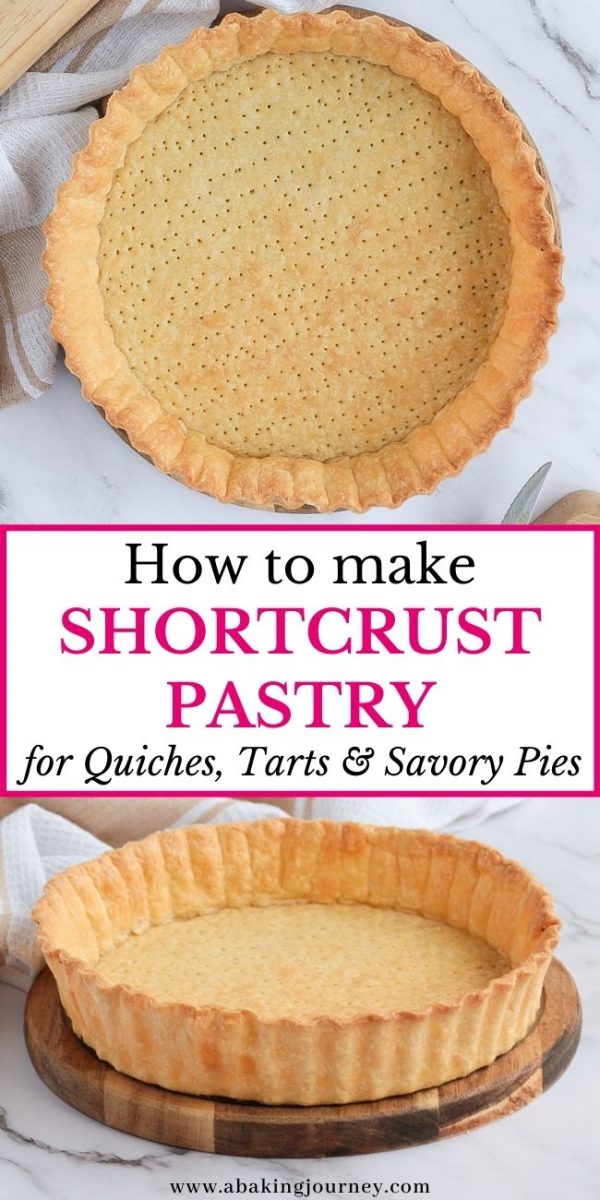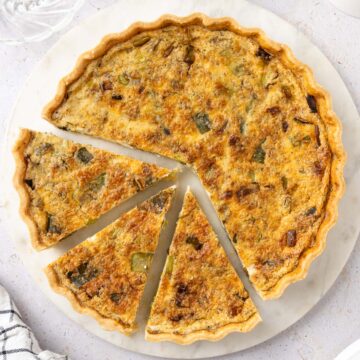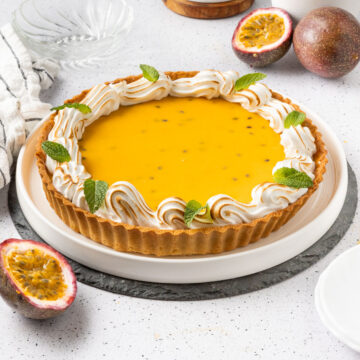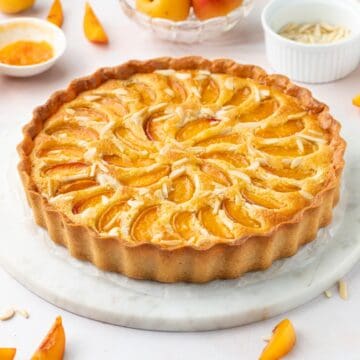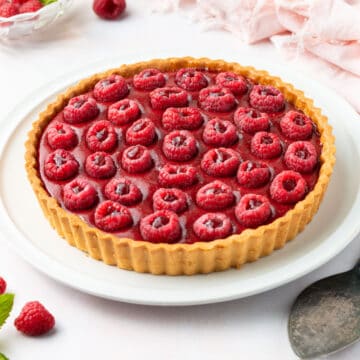This 4 ingredients Savoury Shortcrust Pastry for Quiches, Tarts & Pies is super quick and easy to prepare in the food processor. The simple savoury pie crust is so deliciously flakey and light - you will never want to buy a pre-made one ever again!
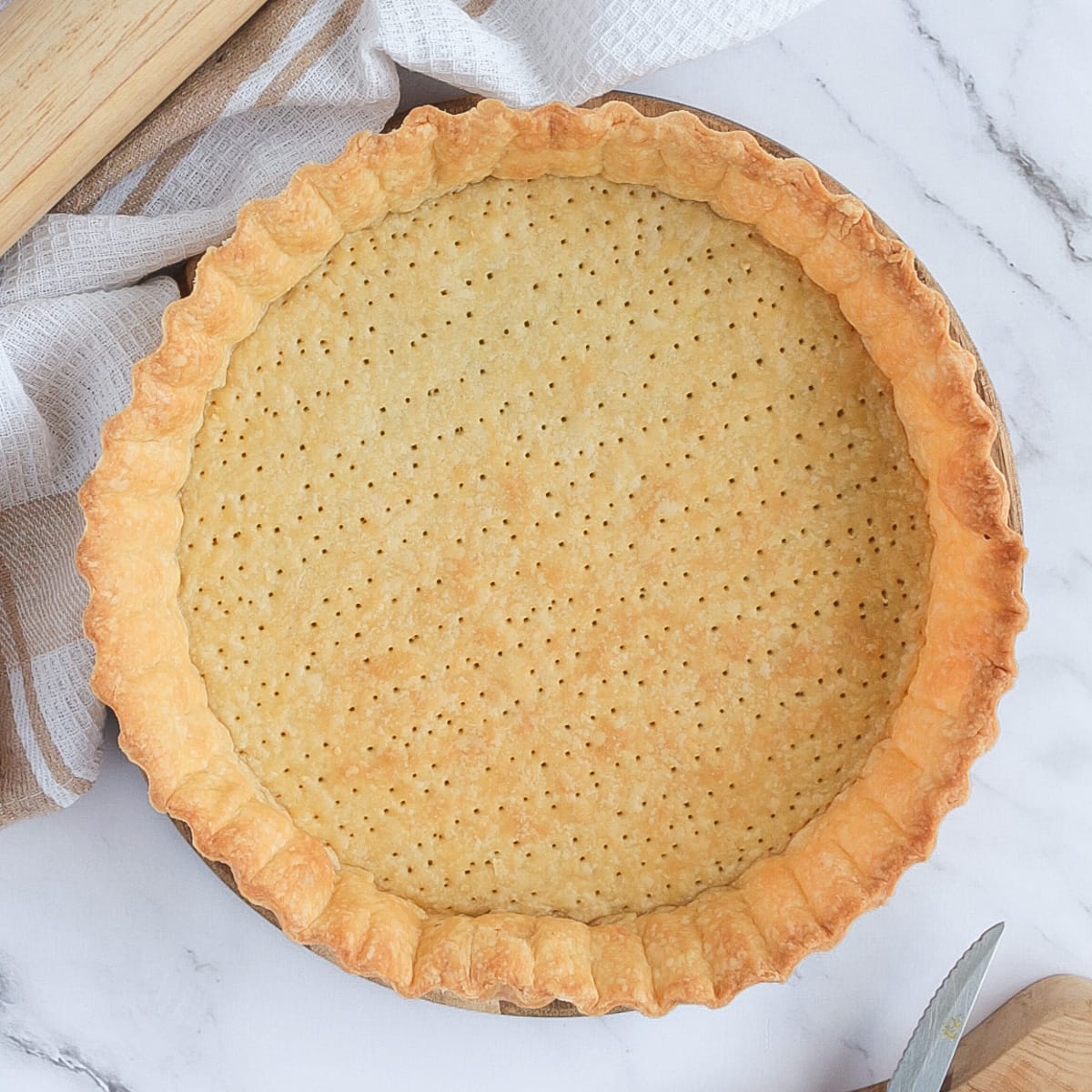
Jump to:
Why we love this recipe
This Savoury Tart Crust recipe is probably one of the most used recipe in my kitchen, ever! I LOVE making and eating tarts and they are most often sweet ones with a Sweet Shortcrust Pastry, Pâte Sablée or a Chocolate Pie Crust. But when it comes to main meals, I equally love making Quiches and Savoury Tarts that require a different type of pastry.
Having a simple savoury pastry recipe that is both super easy and super quick to prepare always comes in handy. And this recipe is so versatile. You can use it to make quiches like this Spinach and Feta Quiche or savoury tarts like my Leek Tart. It would be perfect for a savoury pot pie too!
Making your own Quiche Pastry with Butter is the best way I know to get a deliciously flakey and flavourful crust. It is something a store-bought shortcrust pastry simply cannot recreate!
I know that Pastry can sometimes be intimidating but trust me - as long as you follow the resting and chilling time, your pie crust will turn out perfect every time.
Ingredients
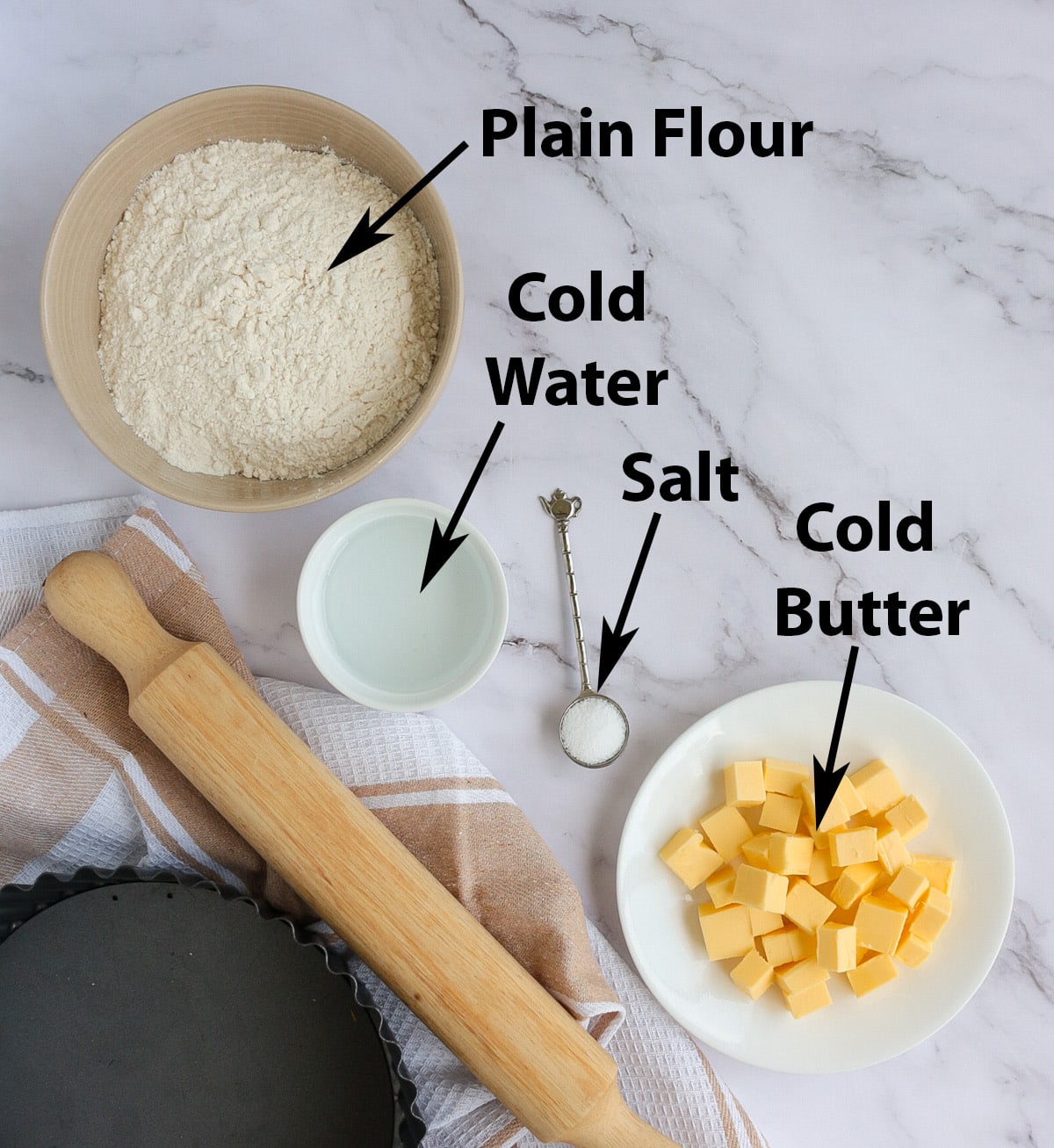
This pastry is made with super simple and basic ingredients that most people have in their pantry / fridge. And you only need 4 ingredients!
- Flour: Plain / All-Purpose flour, sifted.
- Salt: I use simple fine table salt.
- Butter: unsalted and very cold, cut into small cubes.
- Water: very cold. You could use milk instead for a richer taste.
Optional Addition
You can also add any Spices or Dried Herbs to this mix to customise this recipe. I personally love to add Ground Cumin or Cumin Seeds.
You could also use some Chilli Powder or Flakes, Dried Basil, Parsley or Oregano, Curry Powder or Paprika for example... the possibilities are infinite!
Basic Shortcrust Pastry Ratio
One of the best thing about this recipe is that it follows a simple 1:2:3 weight ratio, which means that you can very easily make larger or smaller quantities of dough if needed.
It goes like this:
- 1 part Flour
- 1/2 part Butter
- 1/3 part Water
So for 180 grams of Flour, you would add 90 grams of Butter and 60 grams of Water. So easy!
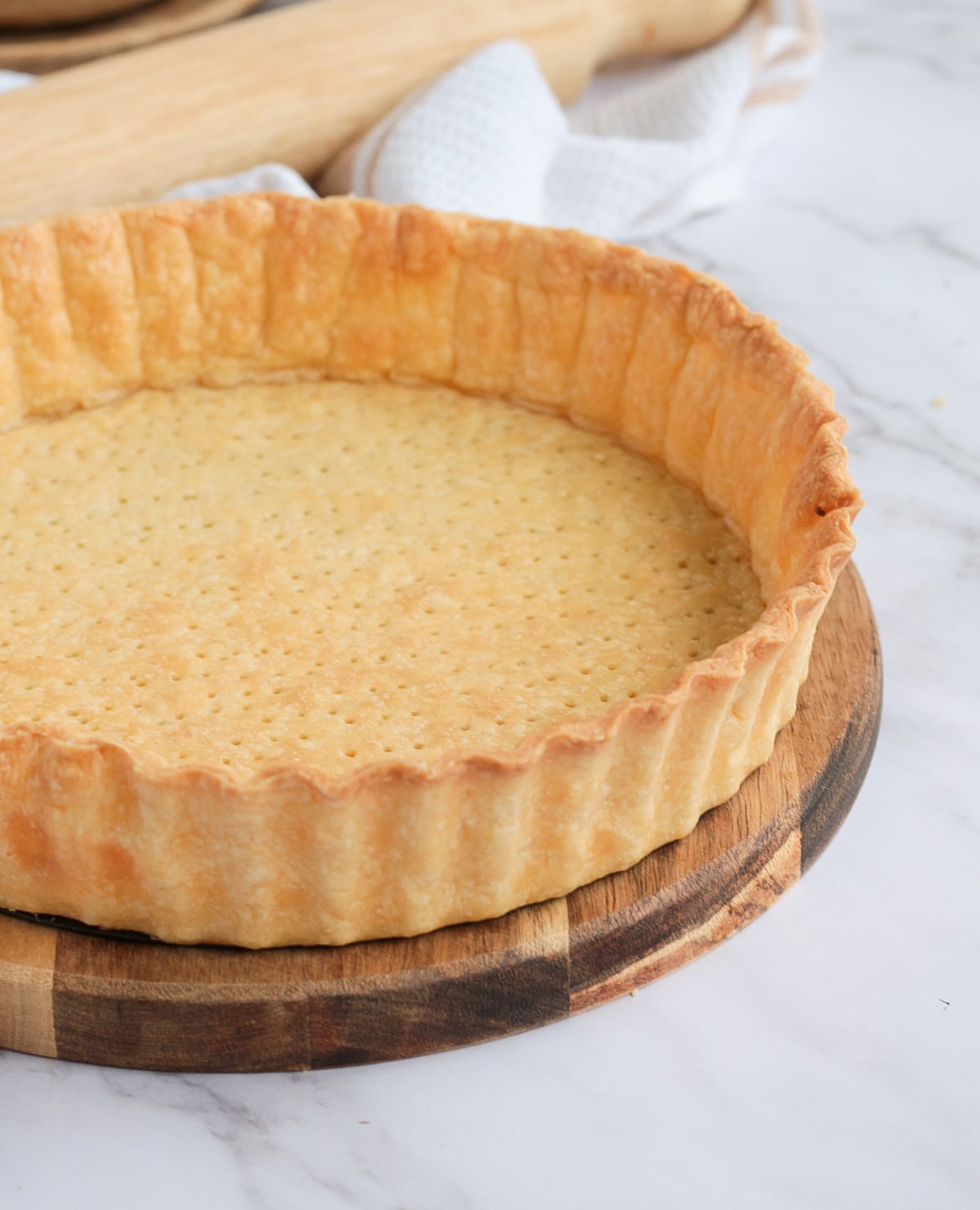
How to make Savoury Shortcrust Pastry in the Food Processor
Making this Savoury Pie Pastry is extremely easy - especially when using a food processor. For the best results, you really need to follow the resting and chilling time. It is key to create a perfect quiche crust that does not shrink or collapse in the oven!
Here is how to make this savoury pastry crust in the food processor:
- Photo 1: Place the Flour and Salt in the bowl of your Food Processor and pulse to mix.
- Photo 2: Add the very cold Butter, cut into small cubes.
- Photo 3: Slowly pulse to cut the butter into the flour. Continue until you get a thin crumb, wet sand like consistency. The larger the butter chunks, the flakier the pastry will be but the higher chances of the pastry collapsing in the oven. I personally like to blend the butter into to very small crumbs.
- Photo 4: Add the cold Water a little bit at the time while pulsing. Do not add all the water at once; depending on your flour, you might need more or less than the recommended quantity. So make sure to only add a little bit at the time and blend well between each addition. Stop as soon as the dough starts to come together.
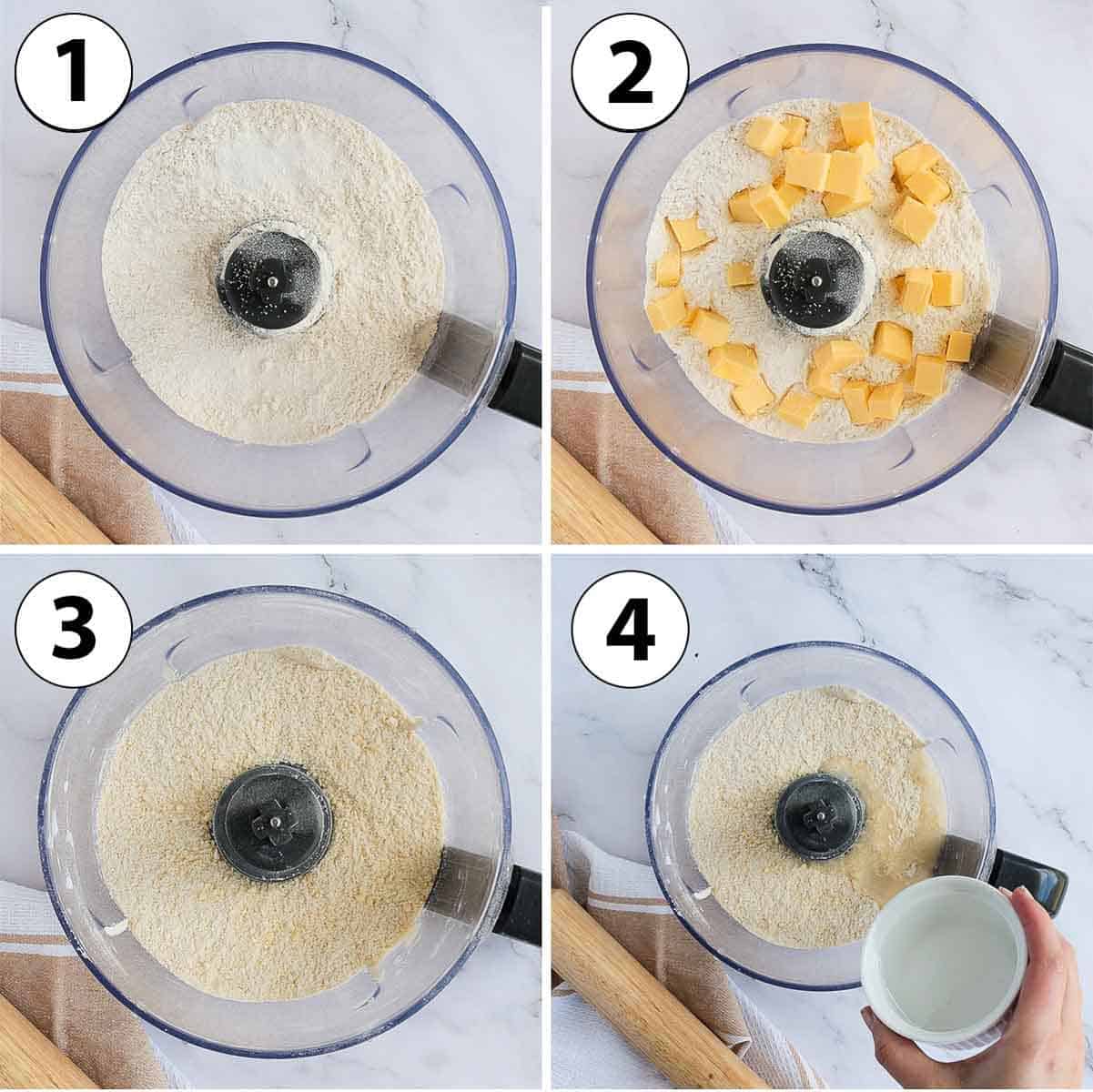
- Photo 5: When the dough starts to come together, stop pulsing. It does not need to be fully combined into a ball, but the crumbs should stick together when you pinch them between your fingers. It is important not to work the pastry too much as this point.
- Photo 6: Transfer the pastry over a sheet of baking paper on your kitchen bench.
Once the pastry dough is ready, it is time to roll it, rest/chill it and line the tart or quiche pan.
- Photo 7: Bring the dough together into a ball and gently flatten it with your hands. If the pastry seems sticky, dust each side with a little bit of flour.
- Photo 8: Cover with a second sheet of baking paper and leave to rest for about 10 minutes. This will help relax the gluten and make it easier to roll.
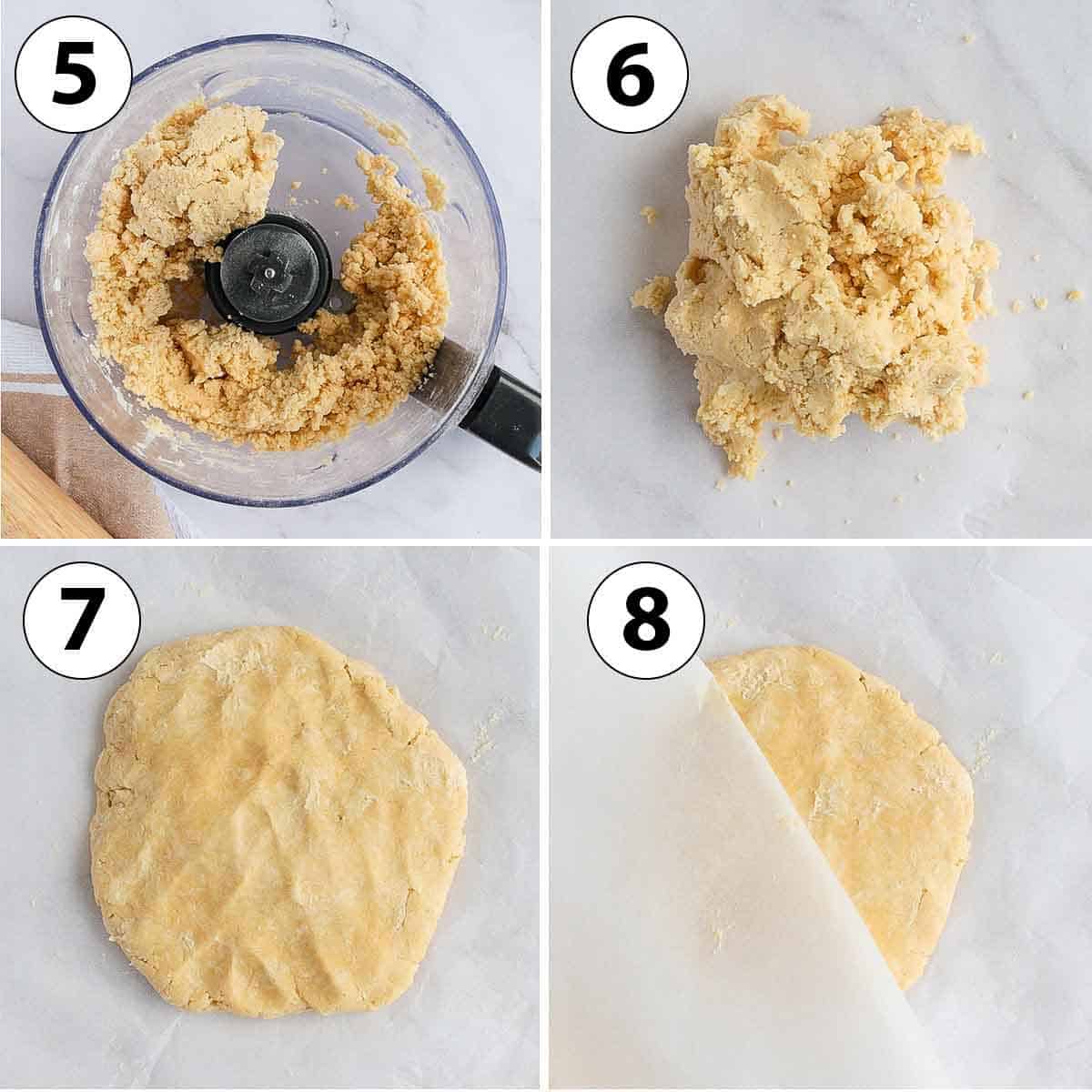
- Photo 9: Roll the dough with a Rolling Pin. For a perfectly even thickness, you can use a rolling pin with thickness rings. The easiest way to roll pastry is to only roll in one direction, turning the pastry around instead of the rolling pin. For me, the best pastry thickness is about 3 to 4 mm - 1/6 to 1/8 inch.
- Photo 10: Place your Tart or Quiche pan over the rolled pastry to insure it is rolled large enough to fill it.
- Place the rolled pastry over a flat tray and leave to rest in the fridge for at least 1 hour (or up to 24 hours).
- Photo 11: Remove the baking paper sheets and transfer the pastry over your Tart Pan. Gently slide the pastry along the sides of the pan to create a 90' angle with the bottom. Press it against the edges of the pan so it sticks to it, then use a small pairing knife or a rolling pin to cut off any excess.
Don't worry if the pastry cracks or some areas are too short to fill the pan - you can simply patch it up with your fingers and using leftover pastry. You can also watch this video that will show you how to line a tart tin if needed!
- Photo 12: Dock the Pastry with a knife (poke holes all over the bottom of the crust), then place it back in the fridge to chill and rest for at least 1 hour (or up to 24 hours).
- Preheat your oven on 180'C / 350'F. While the oven is preheating, place the pastry in the freezer so that it is very cold, almost frozen, when you place it in the oven. Blind-Bake or Bake according to your quiche or tart recipe instructions.
Note that if you are making it in advance and will leave it unbaked in the fridge for a while, you want to cover the pastry with wrap or baking paper so that the pastry does not dry out.
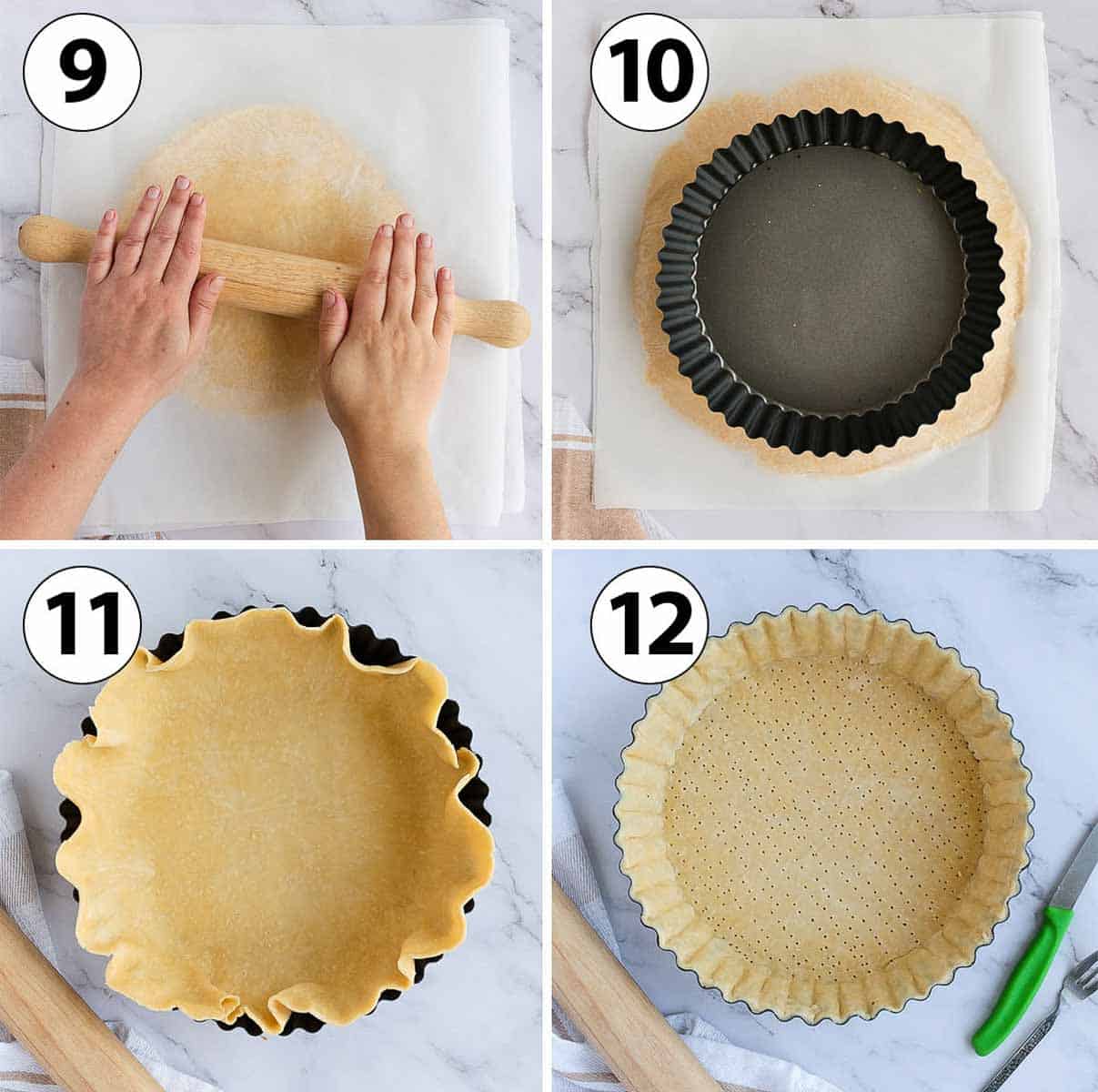
Tips to make Quiche Pastry at home
- Make sure the Butter and Water are really cold. This is the best way to create a very flakey pastry - and insure it does not collapse in the oven.
- Add the Water a little bit at the time. The quantity of water needed really depends on the flour you use; you sometimes needs a little bit less or more of it. So make sure to add it slowly and stop as soon as the dough comes together.
- Do not overwork the Pastry. The more you touch it, work it , knead it, the more gluten you develop in the dough. This will create a tough pastry that has more risks to collapse in the oven.
- Follow the resting time instruction. If you do not rest the pastry for long enough, it will shrink, move or collapse in the oven. Resting the pastry allows for the gluten contained in the flour to relax - which will help the crust to not move when baked.
- Chill the pastry before baking it - I even like to freeze it just before placing in the oven! This is to insure the butter is very very cold when it gets in the oven and helps the pastry to properly puff.
- Don't forget to dock the pastry - which means poking small holes all over the bottom of the pastry with a fork. This will help to avoid having the pastry puff too much and create large pockets of air.
- Use a Tart or Quiche Pan with a Removable Bottom Plate. It's the easiest way to pop out your dish to plate and serve it. I personally like to use Metal Pans over Ceramic or Glass.
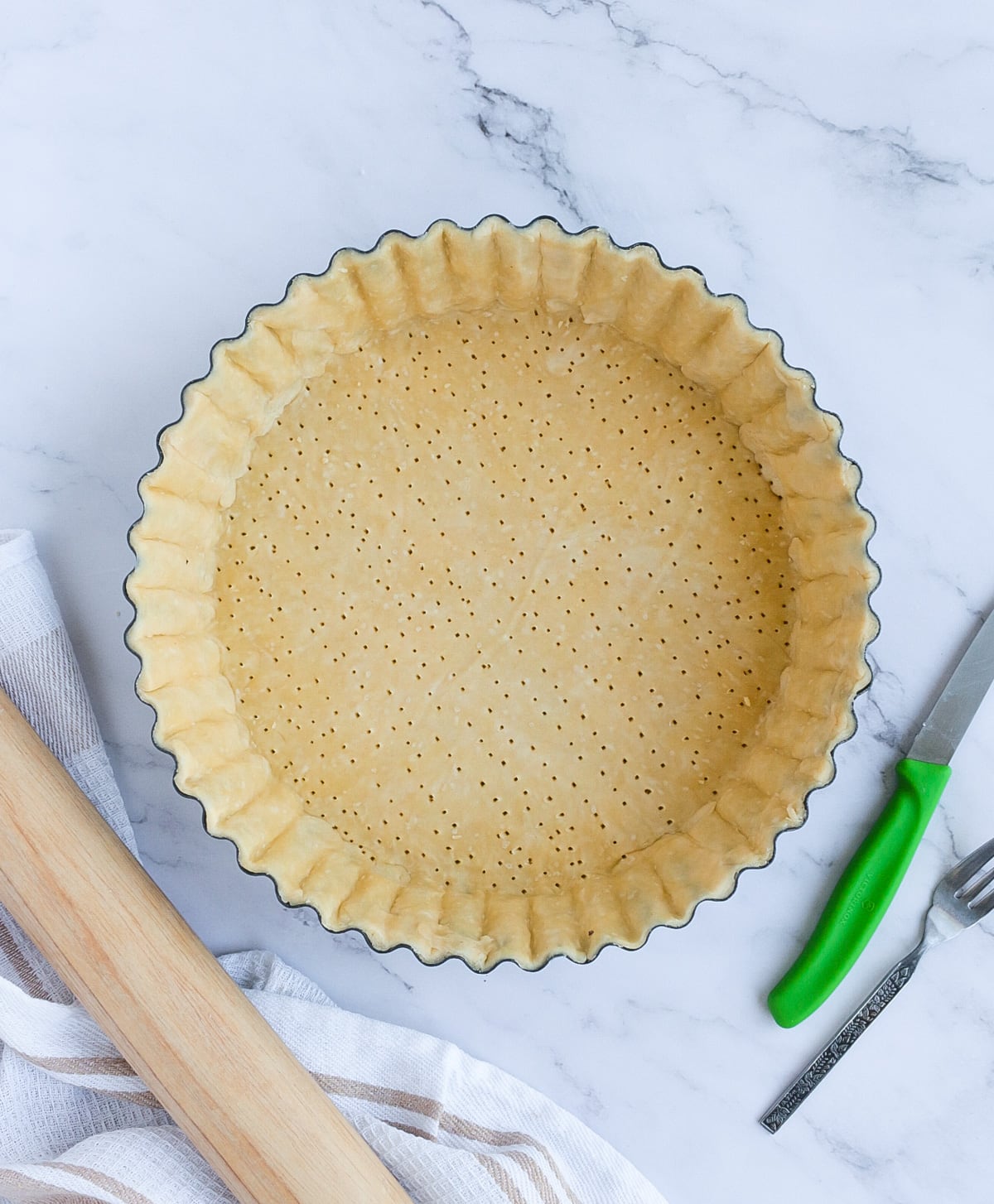
Recipe FAQs
It can absolutely be made with no food processor if you do not have one. The process is the same, but you will need to cut the butter into the flour by hands (or with a Pastry Blender).
That means rubbing the cold butter and flour between your fingers and hands until you get a thin crumb, wet-sand like consistency. You can leave large lumps of butter for an extra-flakey pastry, but I personally prefer smaller pieces of butter.
It really depends on the recipe you use for the filling - always check what they recommend doing!
But as a general rule, if I use a rather liquid filling (for a quiche like my Cheese and Tomato Quiche or a deep pie), I blind-bake it for about 15 minutes just to get the bottom of the pastry slightly dry.
For a more solid filling (for a thinner tart savoury tart like my Goats Cheese Beetroot Tart or a galette like my Tomato Galettes), I usually do not blind bake the pastry.
I personally don't use weights or beads but you absolutely can if you feel more comfortable with it.
Yes - it can easily be stored in the fridge for 24 hours (or up to two days, but it will tend to be drier) before you bake it. I like to keep it in the fridge either pre-rolled, or already lined in the tart pan.
Also yes - you can make large batches of it in advance and keep them in the freezer for 2 to 3 months well wrapped with plastic wrap and/or aluminium foil. Leave it to thaw in the fridge before rolling it, and make sure to follow the recommended resting time.
If you have space in your freezer, you can also freeze it pre-rolled or lined inside the tart pan (if using metal) then remove the pan once fully frozen! Just don't forget to place it back in the pan when baking it. It does not need to be thawed before baking if already in the pan.
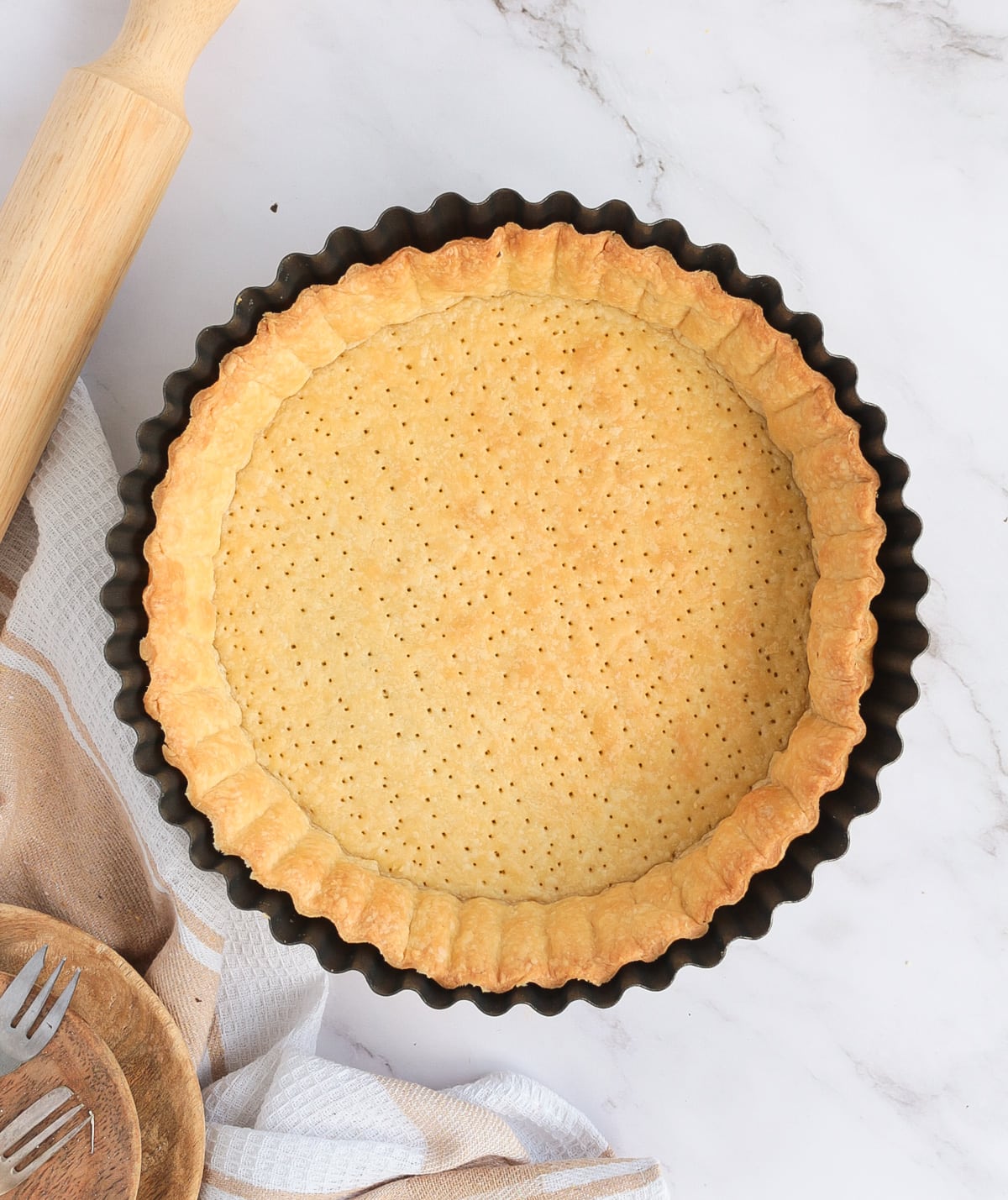
Shortcrust Pastry Troubleshooting
Making the perfect every time comes with experience, and you will soon learn how to fix the different little problems that could arise along the way.
Here are a few tips on how to fix these issues:
- The pastry is quite sticky: add a little bit more Flour
- The Pastry is rather dry or does not come together: keep adding a little bit of cold water, one tablespoon at the time, until you get the right consistency.
- When I try to roll it, the pastry pulls back or is hard to roll: simply rest it for 10 to 15 minutes to relax the gluten, then try rolling it again
- It collapsed in the oven: that can be due to not enough resting time, the pastry not being cold enough or the temperature of your oven being too high. You can use Pie Beads or Weights to help too.
- The pastry is starting to burn / get really brown: that can often happen when you blind-bake the pastry before adding a liquid filling that requires a long baking time. Simply cover the pan with aluminium foil and continue the baking until the filling has set.
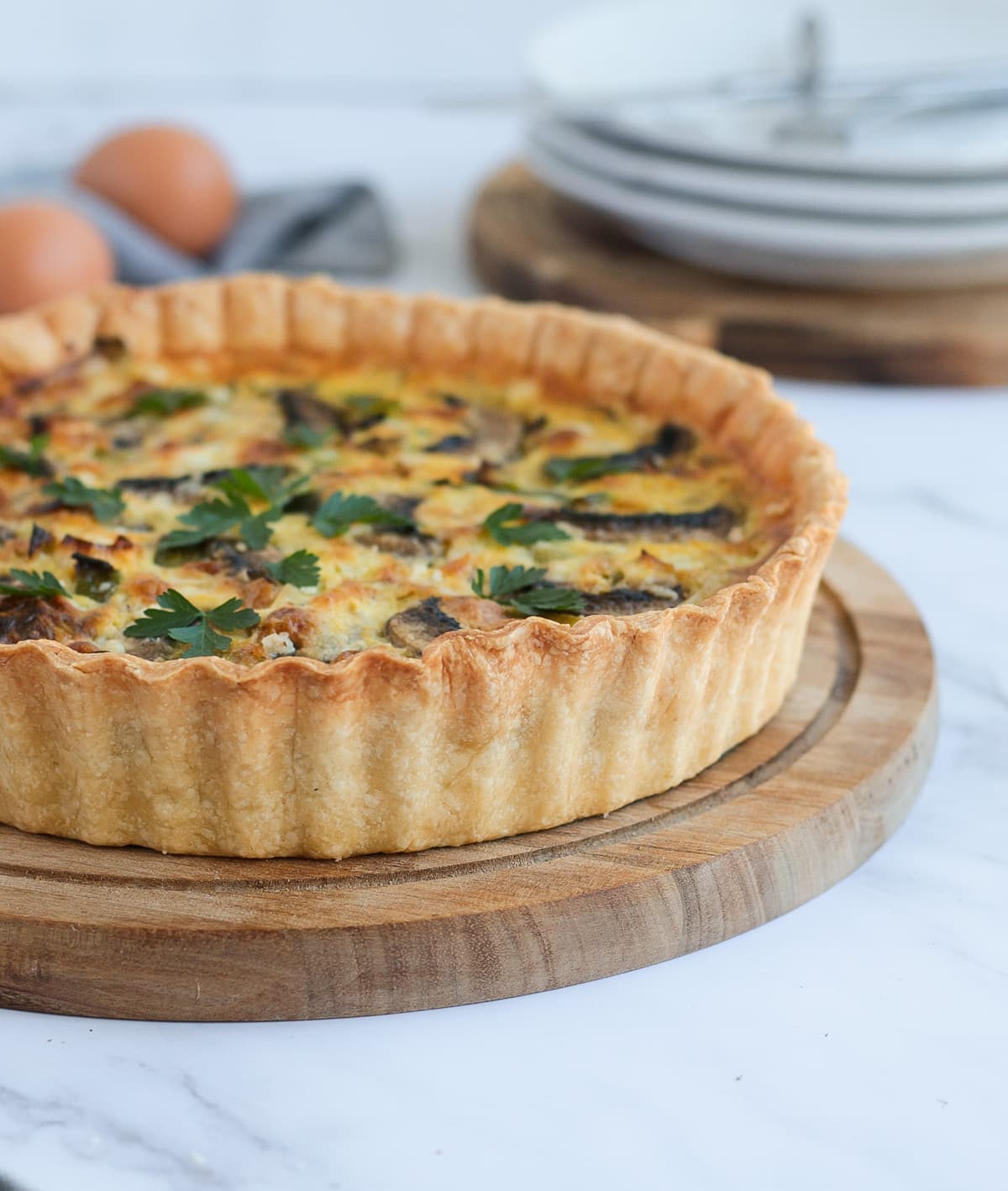
Made this recipe?
Let us know if you liked it by leaving a comment below, and tag us on Instagram @a.baking.journey with a photo of your creation!
Recipe
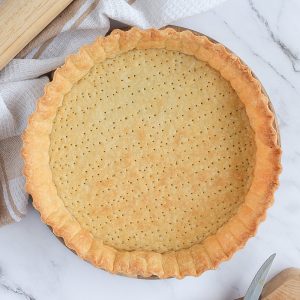
Savoury Shortcrust Pastry for Quiches and Tarts
Ingredients
- 200 gr (1 1/3 cup) Plain / All Purpose Flour
- 1/2 teasp. Table Salt
- 100 gr (7 tablesp.) Unsalted Butter - very cold
- 65 ml (1/4 cup) Water - very cold
Disclaimer
I highly recommend using the measurements in grams & ml (instead of cups & spoons) for more accuracy and better results.
Instructions
- Place the Flour and Salt in the bowl of your Food processor and pulse to mix.
- Add the very cold Butter, cut into small cubes, and slowly pulse to blend it into the flour until you get a thin crumb like consistency.
- While pulsing, slowly add the very cold Water a little bit at the time. Stop as soon as the dough comes together (see note 1) and transfer over a sheet of baking paper on your kitchen bench.
- Assemble the dough into a ball and gently flatten it with your hands. Place a second sheet of baking paper over it, and leave to rest for about 10 minutes.
- Roll the Pastry into a large circle (see note 2) about 4mm - 1/8 inch thick. Place the tart pan over it to check it is rolled wide enough to fill it.
- Place the rolled pastry over a flat tray and leave in the fridge to rest for at least 1 hour (or up to 24 hours).
- Remove the two baking sheets and place the rolled pastry inside the Quiche/Tart Pan. Gently slide down the pastry along the sides of the pans, then press it against the pan so that it sticks to it. Remove any excess with a small pairing knife or rolling pin (see note 3).
- Poke the bottom of the pastry with a fork, then place back in the fridge to rest for at least 1 hour (or up to 24 hours). Just before baking the pastry, place it in the freezer (for at least 15 minutes) to make sure the butter is extremely cold, almost frozen.
- Bake according to the recipe instructions - either blind-baked for 20 minutes at 180'C/350'F filled with baking paper and baking weights (beads, dried beans, rice etc...) or directly with the filling.
Tried this recipe? Make sure to leave a comment and star rating below!
Notes
- Depending on the flour you use, you might need a little bit more or less water. Make sure to slowly add the water, blend well between each addition and stop as soon as the dough seems to come together. There is enough water if the crumbs stick together when you pinch them between your fingers. If very wet or sticky, you probably added a little bit too much water. Simply add a little bit more flour.
- The best way to roll a pastry is by going in one direction only, and turning the pastry 90 degrees instead or turning the rolling pin the other direction. The thickness of the rolled pastry should be about 3 to 4 mm - 1/6 to 1/8 inch
- The best way to avoid a collapsing pastry in the oven is to insure there is no air gap between the sides and the bottom of the pastry. Make sure the bottom corners are packed tightly against the pan. If the pastry cracks or is too low around some parts of the pan, simply patch it up with your fingers and use any excess dough where you are missing some.

